► Hot hatch mega-test 2025
► Golf R vs Merc A35 vs BMW M135
► The year’s best pocket rocket revealed
Remember the six-cylinder super hatch of the 1990s, when BMW transformed its 3-series into the Compact and VW slotted a VR6 engine into the Golf? The new BMW M135, VW Golf R and – a later addition to the niche – Mercedes-AMG A35 we’re pedalling over a damp North York Moors might be those cars’ much-altered descendants, but they’re no longer the premium curios the 323ti Compact and Golf VR6 once were.
Today they’re three of the last petrol hot hatches standing, and they’re so similar on paper (if not to drive) that they could’ve been built to an FIA rulebook. All get transverse 2.0-litre turbo fours with all-wheel drive and a DCT transmissions, churn out around 300bhp, sprint from 0-62mph in under five seconds, officially return mid-30s mpg and cost mid-£40s to £50k.
They’re like Group A homologation tributes with a load more posh, and we’re driving them over this slick moorland road like we’re shaking the final drop of ketchup from the bottle.
The BMW M135’s windscreen fills with Golf R as we power into a crest, the snaking road ahead briefly vanishing as the topography ratchets up. Over the Golf goes, its suspension grasping for the ground like a cartoon character’s legs spinning mid-air before it lands with gymnastic elasticity.
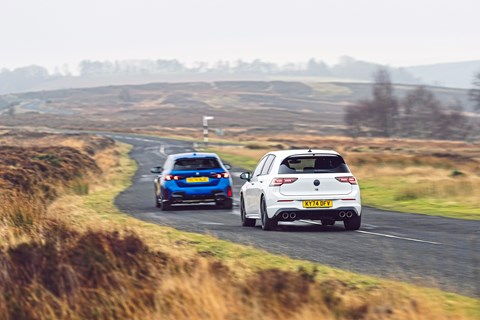
I don’t even think former chassis engineer and friend of CAR Ben Pate lifts the throttle, the R just bites into the surface and slingshots through a sequence of flicks as its torque-vectoring tech gets to work.
A beat later and the M135 flares into torque steer as its nose lightens and excess power bleeds away through its front tyres. When it compresses on its suspension, I floor the throttle and the BMW sweeps hungrily into the apex, its all-wheel drive working all four contact patches equally hard.
Piers Ward is rear gunner in the Merc, locked on like he has missile launchers for paddleshifts. Every glance I steal in the rear-view, there’s a glinty stare looking back at me and a basking-shark gob threatening to swallow me whole (the Merc looks pretty angry too).
The fourth-generation F70 BMW 1-series I’m driving is freshest-on-test by a whisker. Five years since its predecessor abandoned the rear-drive six-cylinder USP, the new M135 has been updated as part of an unusually comprehensive facelift for BMW’s 1-series generally – its ‘i’ suffix needlessly stolen by Munich’s electrification department despite being as BMW as kidneys and kinks (also note the ‘35’ is now smaller than the 1, suggesting other M1 variants might follow).
The body is 42mm longer and – far less common for a facelift – height increases 25mm, plus there’s a lower front end, reworked kidney grilles and fresh LED headlights. It all looks a little bulbous, like David Attenborough should be narrating it.
You drop reasonably low down into comfortable, figure-hugging bucket seats and an all-new cabin with a premium, angular sort of architecture crowned by BMW’s dash-spanning Curved Display. Overall it looks good, though some prominent plastics are hard and sound hollow when you tap them, and the previous model’s rotary iDrive controller is gone – the touchscreen, voice activation and a multi-function steering wheel are now your options for controlling the infotainment.
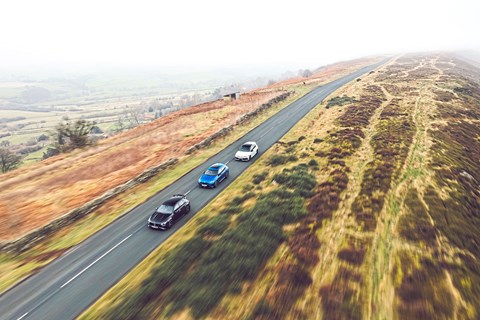
The BMW is not particularly spacious in the back for a transverse C-segment hatch. A high pew, low roof with scalloped headlining and constrictive front seat backs all wind me into a hunch like a mollusc recoiling into a shell. At least the boot’s biggest on test, if only marginally so at 380 litres.
For all that’s new, the M135 continues to be based on the UKL2 platform shared with the previous-gen Mini Countryman and Clubman. BMW claims ‘significantly enhanced performance characteristics’, which is strange given power actually falls by 6bhp to 296bhp, torque by 37lb ft to 295lb ft. Blame those increasingly stringent emissions regulations, and not having the mild-hybrid tech fitted to BMW’s new 120-not-i.
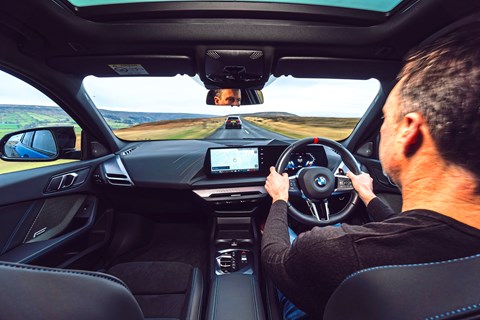
To be fair the BMW’s still a perky little thing to hustle, with a swell of midrange torque and snappy gearshifts courtesy of a new seven-speed dual-clutch ’box that supersedes the previous generation’s eight-speed automatic. But while turbo lag doesn’t exactly jump out at you, there’s more turbo lag than the others, plus the M’s burbly soundtrack is so synthesised I half expect a ‘bossonova’ demo mode (actually I’d prefer one over the batshit ‘digital art’ offered in the same sub-menu as actual driving modes).
Despite the power shortfall, other stuff does a load of ‘performance’ heavy lifting for the BMW, including a stiffer body structure and significantly revised suspension, which includes ‘highly preloaded’ mounts for the anti-roll bars, 20 per cent more caster and new M adaptive suspension.
On the way up here I’d tossed the BMW about and enjoyed its fleet-footedness and the directness of its steering, though a slightly sleepy spot at top-dead centre disguises its absolute urgency beyond that, and the helm generally has a thick-set, highly isolated sort of chunk.
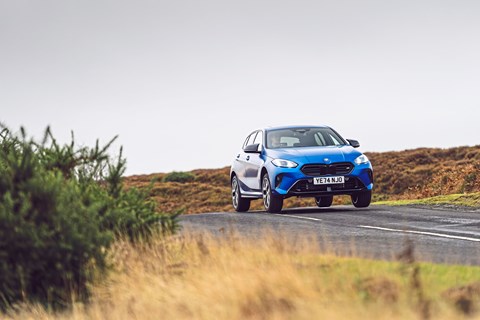
The body is nicely locked down, traction feels very much four-square if you work the chassis hard, but the M135 also combines that authority with a playful edge. Yet even on the lockstops it exudes a very rounded, rubbery feel as the front bites and the rear pivots, like it’s fooling about in a wet suit and flippers. The BMW also does that torque-steery thing when its nose goes light, as though xDrive isn’t chucking power rearwards quickly enough.
While the M135 is the most affordable hatch here at £43,000, it’s actually most-expensive-on-test thanks to £11k of optional extras. Much is consumed by the Technology pack (£2750), M Sport Pro package (£2075) and ‘frozen’ paint (£2100), but key to the drive are M Sport seats, 19-inch alloys (18s are standard) and to a lesser extent the panoramic roof given it puts a few extra kilos in the wrong place.
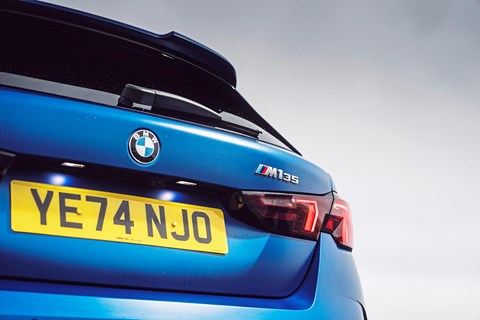
BMW does, however, offer an M Dynamic pack (not fitted to this early car). For £3k it adds drilled brakes, lighter alloys, stickier tyres and a track-optimised chassis, all of which should sharpen the M135’s claws.
The prospect of a stiffer ride is a little worrying, because I’d driven up here perplexed by the BMW’s highly reactive and tightly coiled suspension, which refused to settle when I pushed on over a boggier landscape with tricky primary undulations.
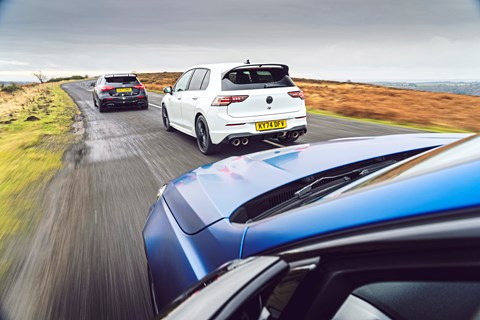
When Ben P jumped in and described it as plush and Piers decreed it absolutely fine, I started to wobble like a witness under cross-examination, only to discover the M135 runs M Adaptive suspension as standard. This adjusts damping on the fly in response to driving conditions and driving style, but if you chase the performance on a tricky surface it tenses like a body-builder flex. The more committed your driving style, the worse it becomes.
‘The primary rate change of acceleration can be violent, but at other times there’s a plushness to the chassis,’ comments Ben P. ‘It’s a bit of a lottery what sort of ride you end up with but I do think the base tune is far too stiff for Britain.’
Recently refreshed in Mk8.5 guise, the Golf R is only a little pricier than the M135 at £43,895 but this Black Edition variant creeps up to £45,785 and includes the R Performance package that increases top speed to 168mph, adds the larger rear spoiler and introduces Drift and Special driving modes, the latter optimised for the Nürburgring.
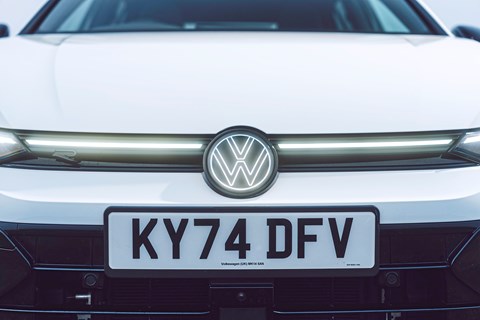
To this Volkswagen UK has added almost £7k of options. Much is accounted for by a panoramic roof (£1250), Akropovic titanium back box (£3395) and – most important to the drive – adaptive dampers (£735).
Meaner looking headlights and an illuminated badge (above) are most obvious of the restrained exterior updates, but the looks weren’t the most troubling thing about the pre-facelift car, which drove like it was self-medicating and had infotainment that could’ve been conceived by Uber-hailing hipsters in a Berlin basement.
Thankfully all of this has been drastically improved with the update, including a much more intuitive if still imperfect MIB4 infotainment system. They’ve even made the temperature and volume sliders illuminated, so you can actually see them at night (though I struggle to find the windscreen demister when poking about at a standstill).
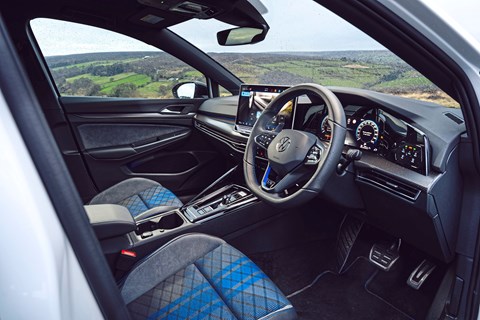
You still drop down low into the Golf’s pleasingly squidgy and highly supportive fabric sports seats, grip a thin, firm steering wheel and survey a nicely laid-out cabin architecture. The BMW and Mercedes might be better for premium flash, but this is the sportiest, comfiest and just downright best driving position on test. The rear seats are the most accommodating too, although its boot is 30-40 litres smaller than its rivals’.
Power of 328bhp with 310lb ft is the most generous here, and on a par with the Golf R 20 Years edition from a couple of years back. Perhaps it’s the delivery, perhaps VW is just low-balling but it feels juicier than that – there’s a proper kick here, an up-for-it attitude previously absent, like the Golf’s always ready to step up and deliver more go, even when you’re already really on it.
Go looking for lag and you’ll find a little delay, but when you’re running at speed this motor just always feels hungry – crisp throttle, generous surge of speed and a decisive snap shut when you back off the throttle. It reminds me of that ‘pop’ when you really connect with a table-tennis ball. It’s all extremely incisive, mirroring exactly what you tell it to do.
The soundtrack is perhaps still quite mild-mannered given this one sings through the Akropovic rear silencer, and the DCT gearchanges are less of an event than shifts in the other cars, but it all sounds and feels more authentic than the BMW and AMG and above all gels together very cohesively indeed.

As before, you get variable 4Motion all-wheel drive, torque vectoring to channel torque across the rear axle to the wheel that can best use it, and suspension some 20mm lower than standard, but the driving-dynamics manager now integrates the all-wheel-drive system into its powerful computing (as well as steering, suspension, throttle etc) and even the Comfort suspension default gets a sportier profile.
It raises expectations that this R has more teeth and heightened response, which is exactly what transpires as I flow it over the moors.
The Golf R remains a pliant, comfortable car but extra fizz now percolates up from ground level, and there’s a lovely freeness to this steering – all lightness and accuracy at speed, it’s like it’s dancing over the landscape, clicking its fingers and pointing at people it fancies as it goes. Doesn’t tug about over crests like the BMW either.
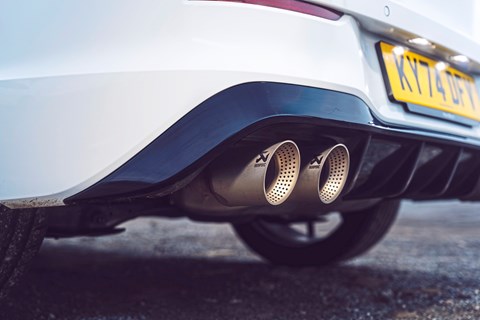
While all this enhanced feel can get a tad noisy through the steering wheel, the overwhelming sensation is of a car that allows welcome extra connection to make its way through to the driver without becoming excessively abrasive.
‘Ride and handling immediately impresses and the Golf just covers ground with such ease,’ notes Ben P. ‘There’s low isolation, probably from stiff bushes, which means lots of vibration through the body, but the Golf’s primary control is very good and its secondary ride isn’t too shabby either.’
The chassis is adjustable in that you can tweak the rear out of line and point the nose at the apex with a well-timed lift of throttle, though it’s perhaps less languid and keener to get itself straight than the others.
Besides, torque vectoring does a lot to tuck you into the turn, a kind of swinging-round-a-post sensation where the harder you run at a corner and the more you dig into the throttle, the more the Golf sweeps in and powers through. It’s a pronounced effect but one you soon dial into, learning to use it as a tool in the Golf’s impressive point-to-point armoury.
If you want more flamboyance, there’s always Drift Mode that lets you throw shapes by pressing the throttle, not just releasing it, as well as a brilliant warning that goads it ‘should only be used by someone with the appropriate driving skills’.
Ben P notes that the DSG can get muddled, especially when overtaking, and it twice refuses to continue in manual mode after spirited blasts. I also get the brakes to stink more than the others, which doesn’t bode well for track work, but up here running over the moors it’s fantastic – especially in its ‘special’ Nürburgring setting that unlocks the fluidity of this chassis and directness of its powertrain without harshness. It could’ve been tuned for a B-road.
Back when BMW and Volkswagen were fitting six-cylinder engines to hatchbacks, Mercedes was preoccupied trying to stop tippy-toes A-Classes toppling over at the sight of deer-based Scandinavian mammals.
It took until 2013 for the A-Class to sire a hot hatch in the shape of the A45 AMG, which remains the £63k 415bhp halo positioned way beyond even the Golf R or M135. The A35 we’re testing slots one rung below with its 302bhp and 295lb ft torque.
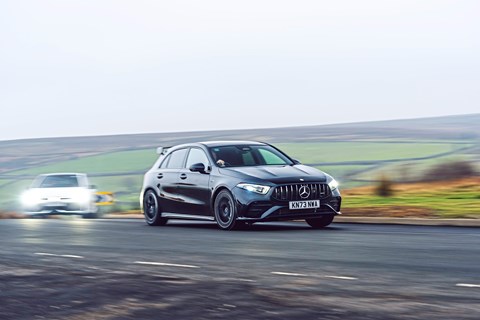
Last updated in mid 2023, the light refresh included a 48-volt mild-hybrid system (13bhp low-speed boost, electrical energy for the ancillaries) and an exterior tickle so gentle I still wonder if Mercedes is pulling our chain.
It also upgraded to the latest MBUX infotainment interface, which (like the BMW) removes the touchpad from the centre console so you now use either the touchscreen, voice or capacitive steering-wheel controls. The latter are so excessively small and unresponsive you might as well be swiping at a smartphone wearing mittens.
Base A35s start from £46,000 with AMG Ride Control adaptive damping, 19-inch alloys and a range of driving modes you can also mix and match in an Individual mode. This one’s the range-topping Premium Plus model, which for £51,005 groups a number of options together, including the Aerodynamics package with its lairy rear wing that’s balanced by little aero flicks on the front bumper. Nothing else materially affects the drive.
Inside, jet-engine air vents, gloss-black trim, perforated leather and brushed aluminium all add to an upmarket interior ambience superior to the others, though the twin drive-mode dials on the steering wheel look and feel somewhat flakey, and the leather seat facings have a wrinkled texture, like skin under a microscope.
Despite being the longest car on test, the Merc’s rear seats are just about okay (tighter than the Golf, better than BMW) but most disappointing are its worst-on-test front seats with their firm bases, lack of lateral support and feeling that they could drop lower still.
But then I fire off down the road and have a proper ‘oh hello’ kind of epiphany in the Mercedes. There’s an unexpected mix of rawness and finesse here, almost as though Porsche’s GT department has turned its hand to a hot hatch. At speed it’s awesomely stable with a long striding, firm-but-compliant chassis, where road surface chatter is allowed to percolate up to you, but all the harshness is dexterously rounded off.
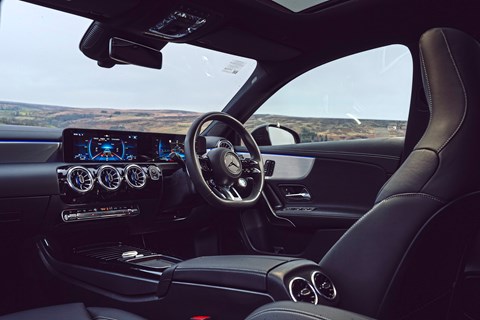
The adaptive dampers even work over this tricky landscape in the Sport suspension setting, though that’s impossible to isolate from the Sport steering map which oddly lacks the reassuring on-centre connection of Comfort. I settle on Comfort suspension with the Dynamic powertrain in Individual mode and have a heart-pounding drive over these sweeping moorland roads.
Tip the Merc into a corner and there’s more roll than you get from the others, especially over its front axle, but it bites convincingly and there’s real grit and texture to the way this car connects with the road surface and powers on.
‘Ride and handling are almost as good as the Golf’s and there’s excellent isolation but also significantly more roll angle than the other two, especially over the front axle,’ feeds back Ben P. ‘That doesn’t reduce its overall capability but the Golf has the steadier, more predictable platform.’
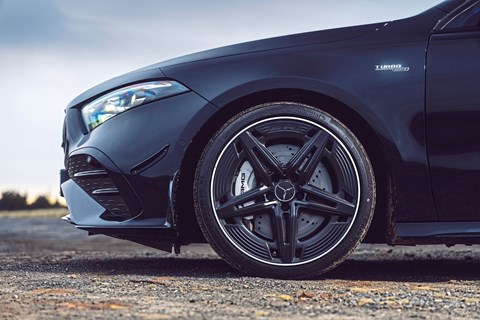
Traction is as mighty and neutral as the others, and while there’s no novelty drift mode here, the Merc’s rear end is so easily adjustable simply by lifting the throttle you just don’t need one.
The growly powertrain sounds no more authentic than the Hyundai Ioniq 5 N’s entirely artificial soundtrack, but this is the most responsive engine on test, the M260 unit having virtually zero turbo lag. That immediacy is compounded by short gearing (this one goes up to eight cogs) and punchy shifts heralded by a kind of /ba-dum/ drumroll. Ingot-like paddleshifters that click tightly convey a sense of directness too.
Atrocious road noise on coarser surfaces is the big downside, most of which floods up through the rear arches like someone’s going at them with an electric sander, and after longer drives, those firm seats also leave my back aching like crazy.
It’s far from a perfect scorecard for the Mercedes-AMG, then, but as a driving tool I reckon it’s underrated and does leave us with much to ponder as we head into Pickering for a meal, a pint and a very thorough sense-check of our test notes…
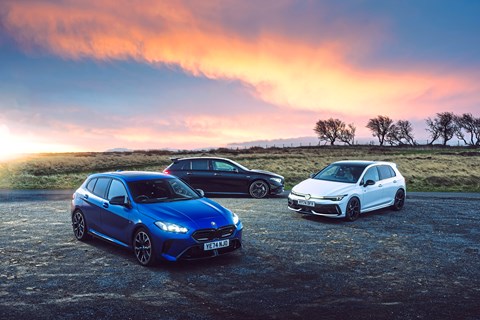
Verdict: small changes make the difference
The M135 bowled into this test with the hype of the new and a snazzy Frozen Blue paintjob, but it’s hard not to feel a little underwhelmed by BMW M’s cheapest model and only hatchback.
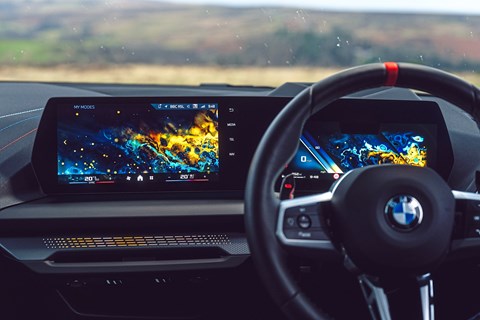
To its credit the M135 is the most affordable car on test, comes with a great cabin and infotainment and is refined at speed. It’s also mostly nicely sorted thanks to punchy steering, a solidly connected rear axle that can live with even ambitiously enthusiastic direction changes and composed body control complemented by sure-footed traction. Despite reduced performance, there’s still more than enough go to have a lot of fun too.
But its isolated chassis, aloof steering and the curious adaptive suspension that becomes less compliant the harder you drive – even on terrible surfaces – all help relegate the M135 to the back of the pack.
The Mercedes-AMG A35 is a perhaps surprisingly raw experience given the premium badge, but it’s also shot-through with real finesse – particularly its chassis’ fusion of isolation, control and the gritty feel that filters through to the driving experience.
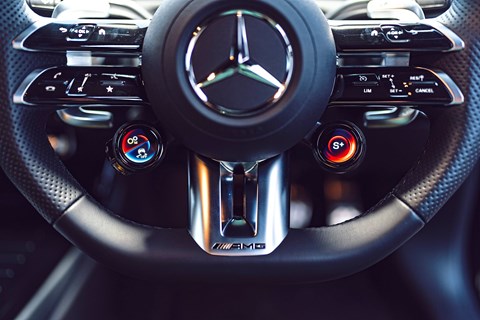
The powertrain is superb, especially its lack of lag, plus its chassis is rock-solid stable at speed, agile through the fun stuff and sure-footed when you work the all-wheel drive for all it’s got.
Negatives include excess road noise on poor surfaces and seats that are both too firm and too unsupportive but the A35’s surprisingly hardcore flavour really endeared it to all three of us.
Plus because it was updated a year or so ago, you can pick up something similar for not much over £30k – and if you are buying used, I would absolutely recommend the A35 over a year-old Golf R, simply because the pre-facelift VW just isn’t as complete as the new one is.
But neither Mercedes nor BMW have an answer for the updated Golf R. On paper the tweaks seem decidedly modest and limited mostly to a much-needed infotainment re-think, but the extra performance and additional connection in this chassis really is transformative. You can terrorise the moors in a Golf R like you might an Impreza, and there’s a flow and attack to a Golf R on a mission that’s so much more satisfying than its somewhat distant predecessor. It’s a great example of how crucial the last bit of fine-tuning really is.
Sealing the deal for the R is the liveability that’s defined every Golf – the excellent front seats, the space in the back, the compliant ride and high levels of refinement. Even the infotainment no longer provokes Basil Fawlty outbursts.
This is a very much improved Golf R, then, one that’s great to drive flat out, easy to live with day-to-day and the clear winner of this test.
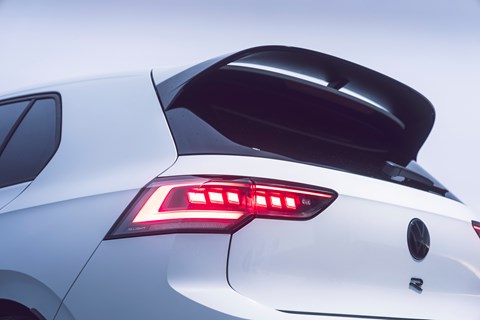
1st: VW Golf R
Best to drive, easy to live with and drastically improved. Even the infotainment’s better
★★★★
2nd: Mercedes-AMG A35
Fabulously gritty feel with compliant chassis, responsive drivetrain. Too much road noise and unyielding seats
★★★★
3rd: BMW M135
Agile, highly capable chassis let down by excess isolation and often unyielding suspension
★★★